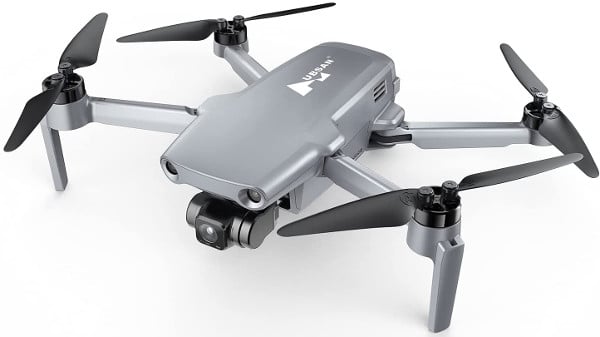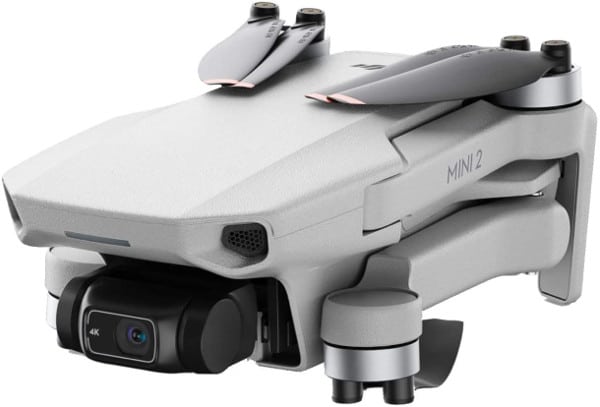Hubsan recently released the Zino Mini drone, a direct competitor to the popular DJI Mini 2. Mini drones are very popular, they are small, lightweight and excellent drones to travel with. The DJI Mini 2 is probably the most popular Mini drone currently on the market, however, there are a few alternatives that you may want to consider like the Hubsan Zino Mini Pro. The main difference between the Hubsan Zino Mini Pro and the DJI Mini 2 is the camera and flight time. Although the Zino Pro technically comes with a better camera, in the real world, its performance isn’t as good as it should be as you shall find out in the Hubsan Zino Mini Pro vs DJI Mini 2 article.
The first feature I like to compare is the camera, this is probably the first feature most people like to read about when they are thinking about purchasing a mid-tier drone like the Zino Mino Pro or the DJI Mini 2.
The camera for the Hubsan Zino Mini Pro comes with a 1/1.3-inch sensor, which is the largest in the Zino range. It captures 48MP images in JPEG, there is an option to capture images in RAW format, but the files in RAW are unreadable and the results are not very good.
The Zino Mini Pro can capture three types of panorama photography and also create time-lapse videos. Both features are accessed via the Hubsan X app.
The camera has a fixed-aperture f/1.85 lens with an 84° FOV and an ISO range of 100-3200.
The camera is stabilised by a 3-axis gimbal, which reduces distortion and motion blur in videos and photos.
The Zino Mini Pro camera can record videos in4k at 30fps, 2.7k at 60fps and 1080p at 60fps. It has a video recording speed of 100 Mbps, although you do get the option to record at 200 Mbps, however, that will use up more memory space.
The DJI Mini 2 comes equipped with a 1/2.3-inch sensor that can capture images in both RAW and JPEG format. The RAW format will provide photographers with more options in post-processing, and it produces better results than the Zino Mini Pro.
The camera has an 83° FOV, an ISO range of 100-3200 and fixed-aperture f/2.8.
Photographers will also enjoy the Auto Exposure Bracketing feature, using this feature, the camera will capture 3 images with different exposures and then stitch them up for an HDR image.
The camera can also capture 3 types of panorama photography, namely, sphere, 180° and wide-angle.
As for video recording, the DJI Mini 2 records 4k videos at 30fps, 2.7k at 60fps and 1080p at 60fps. The camera also has a decent zoom function, it can zoom in 2× while recording in 4k or 2.7k and 4× in 1080p.
Although the Zino Mini Pro comes with a larger image sensor, which in theory should provide capture more image data, in my opinion, the DJI Mini 2 provides better quality videos and photos, especially when it comes to capturing the correct colours.
Flight Features & Performance
The Hubsan Zino Mini Pro and the DJI Mini 2 have similar features, although the Hubsan drone does come with a couple of significant features which are not available with the Mini 2.
The drones have 3-speed modes, the slowest mode is the cinematic or movie mode which will limit the Zino Mini Pro’s speed to3 m/s, while the Mini 2 is slightly faster at 6 m/s.
The other speed modes are normal mode and sports mode, both drones have the same top speed in each of these modes.
Both drones come with a cool feature called Quickshots, which is accessed via their relative apps and allows the operator to record short high-quality videos at the press of a button.
Videos can be recorded from different angles depending on which Quickshot mode you choose. The Zino Mini Pro has 4 Quickshots, while the Min 2 has 5.
Both drones also come with an automatic return to home feature, this feature can be activated manually via the controller or app. It is activated automatically whenever the battery on the drone is low on power or if the connection is lost.
The Zino Mini Pro comes with an obstacle avoidance system, something that is not available with the Mini 2.
Although it’s a good feature to have, the obstacle avoidance system is not as intelligent as systems on drones like the DJI Air/Air 2or Autel Evo drones. The drone will detect obstacles and stop its flight, it doesn’t have the capability to manoeuvre around the obstacle and carry on.
Still, it’s better to have an obstacle avoidance system and the fact that Hubsan have managed to add it to such a small drone is quite impressive.
The Zino Mini also comes with intelligent flight modes, these include active track, point of interest, tap fly and waypoint. The active track mode has image tracking ability, although, it is a bit of hit and miss if you or the subject are going too fast.
As for the overall flight performance, both drones perform well and most of their features work as they should.
The Hubsan Zino Mini has an official flight time of 40 minutes, however, don’t expect to achieve that flight time. However, under good weather conditions, you can probably get between 32-35 minutes, which is more than the DJI Mini 2, which has 30 minutes of flight time.
Both drones use enhanced WiFi for a control range of around 10km, although since drone laws in most countries state that you have to keep your drone in your line of sight, the range shouldn’t matter much.
Something else I want to mention, both these drones weigh less than 250 grams, if you live in the USA and only intend to fly these drones for recreational purposes, you do not need to register them with the FAA.
However, the FAA now requires all recreational drone operators to pass their new The Recreational USA Safety Test or TRUST for short. More information on this test and how to take it can be found on the FAA website.
A similar rule also applies in Canada, however, for those living in the UK, the rules are slightly different. You will need to register any drone that weighs under 250 grams and comes with a camera.
You will need to obtain something called an Operator ID and make sure that the drone has this ID clearly labelled. For more details, please visit the CAA website.
My Choice
My personal choice is the DJI Mini 2, despite coming with some technically inferior features, the drone has proven to be way more reliable and its combo version is much cheaper than the standard version of the Zino Mini Pro. Also, if intelligent flight modes like Active Track & Way Points are important features for you, these flight modes are available via the popular Litchi app.
DJI Mini 2
- 1/2.3-inch sensor
- 12MP images
- Multiple photography modes
- Records 4k video footage at 30fps
- 100Mbps
- 6 Quickshots for one-click cinematic videos
- 30 minutes of flight time
- 10km transmission range
Final Thoughts
Both the Hubsan Zino Mini Pro are impressive drones, however, I would personally choose the DJI Mini 2, even though it comes with fewer features and shorter flight time.
DJI drones are less buggy and more reliable, plus the camera quality is higher. The DJI Mini is also cheaper, however, some people may be swayed by Zino Mini’s extra features and longer flight time.
For more alternatives, click on the button below for a list of the best drones under 250 grams.





Pretty clear bias here – you go with the DJI with inferior specs because you prefer DJI products. Useless review.